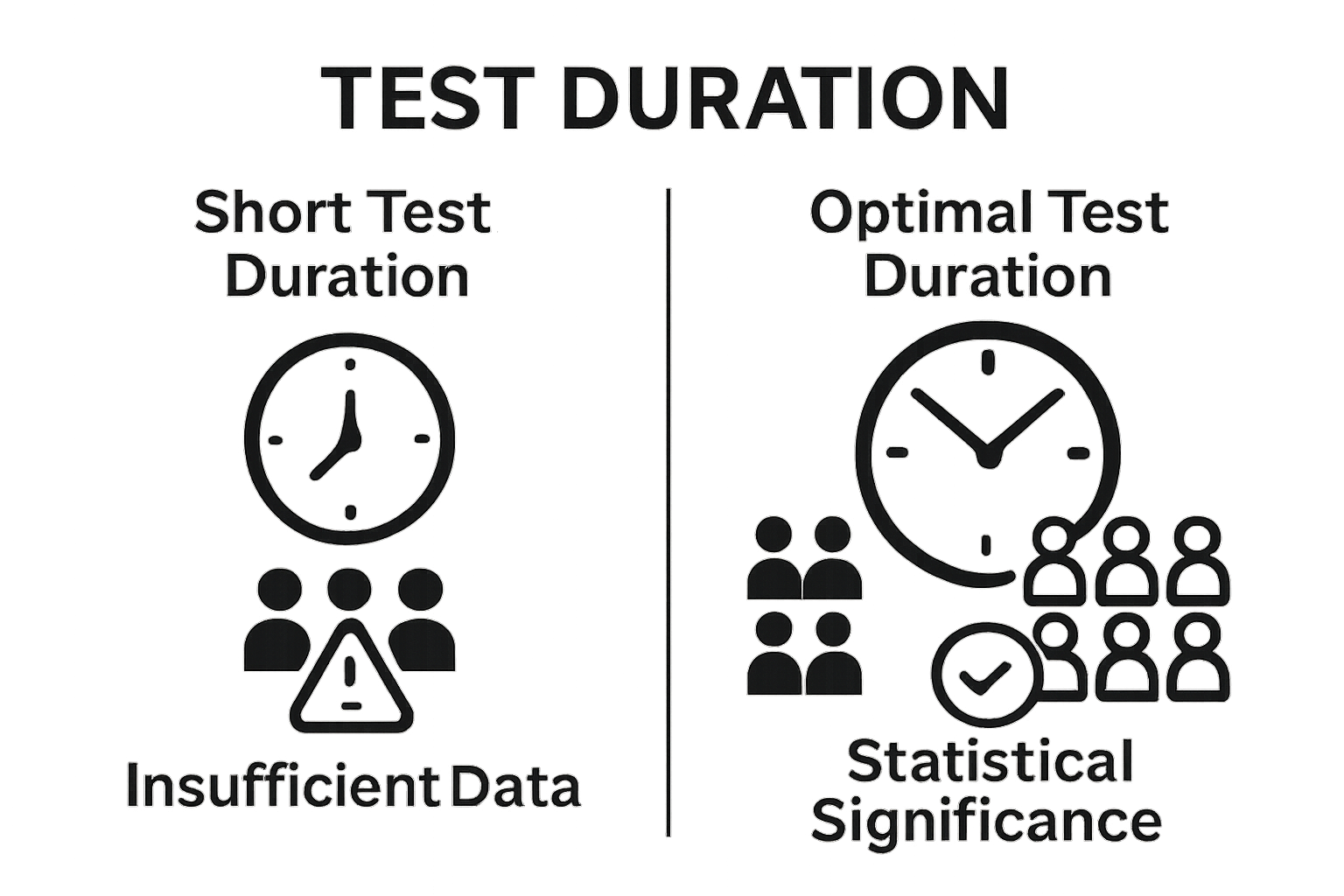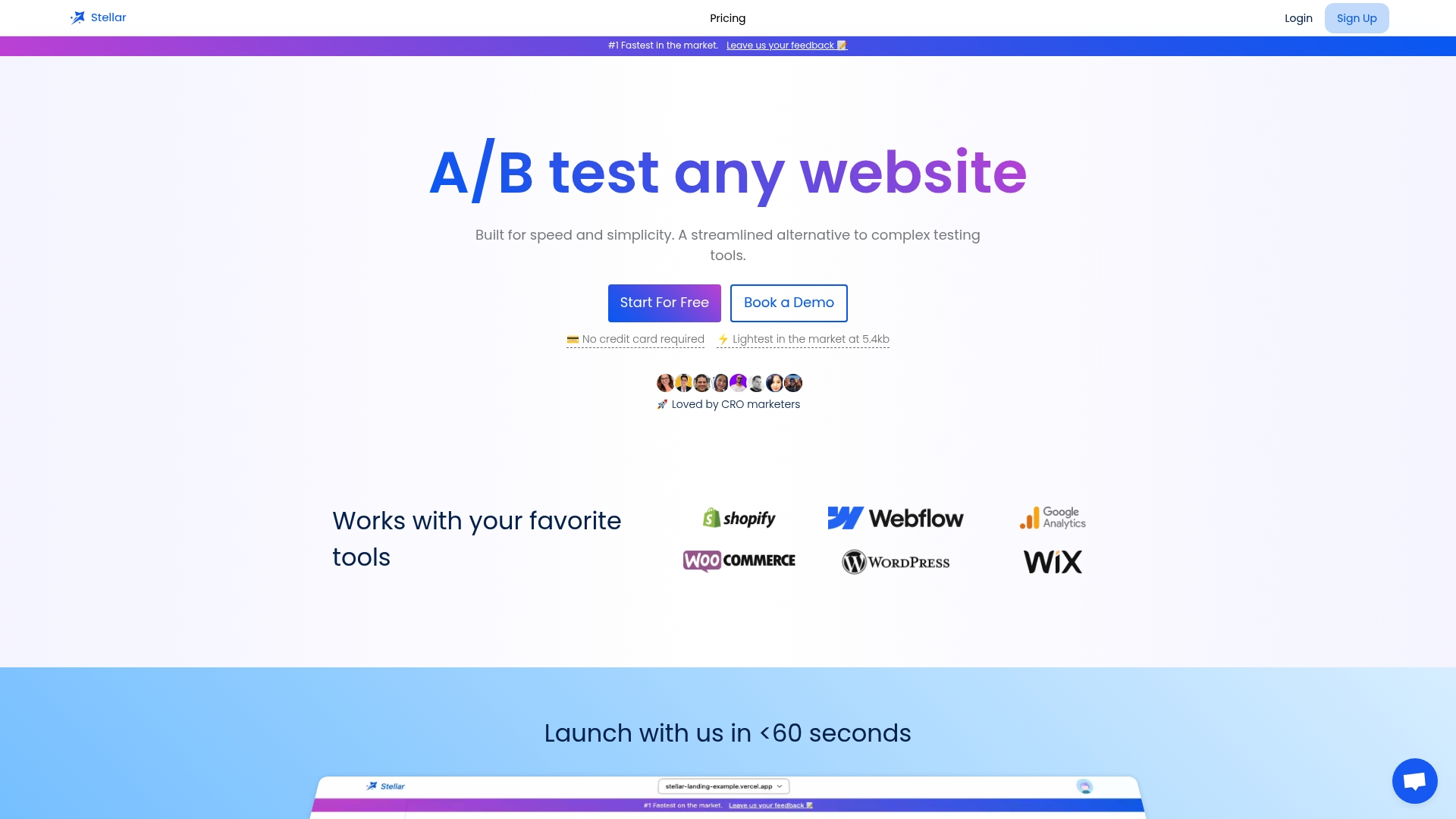
What is Test Duration? Understanding its Importance

Test duration sounds simple, just a measure of how long to run experiments or marketing campaigns. Yet, premature test endings can lead to misleading conclusions and wasted marketing spend. The surprising part is, running tests for too long is just as dangerous, introducing new variables and wrecking your data. Picking the right test duration becomes a high-stakes decision that makes or breaks real marketing results.
Table of Contents
- Understanding The Concept Of Test Duration
- The Importance Of Test Duration In Marketing
- How Test Duration Affects Results And Insights
- Key Factors Influencing Test Duration
Quick Summary
| Takeaway | Explanation |
|---|---|
| Test duration influences data quality | The time allocated for testing significantly affects the reliability of the results obtained from experiments. |
| Sample size is critical for significance | Ensure a sufficient number of participants is included to achieve statistically meaningful outcomes and avoid bias. |
| Avoid premature conclusions in testing | Hasty interpretations can lead to misguided marketing strategies and poor decision-making in campaign adjustments. |
| Monitor traffic variability during tests | Be aware of natural fluctuations in website traffic that can impact experiment results and data interpretation. |
| Balance quantitative and qualitative insights | Combine metrics and user behavior insights to craft comprehensive narratives that drive strategic decision-making. |
Understanding the Concept of Test Duration
Test duration represents the total time allocated for conducting a comprehensive experiment or assessment across various domains, particularly in conversion rate optimization and digital marketing. At its core, test duration defines the precise timeframe during which data is collected and analyzed to evaluate performance, statistical significance, and meaningful insights.
Key Elements of Test Duration
Understanding test duration involves recognizing several fundamental components that influence its effectiveness and reliability. Test duration best practices suggest that multiple factors contribute to determining an appropriate experimental timeframe:
- Sample Size Requirements: The volume of participants or data points needed to generate statistically significant results
- Conversion Volume: The expected number of conversions or interactions during the testing period
- Traffic Variability: Natural fluctuations in website or platform traffic that might impact experimental outcomes
Significance in Experimental Design
In the context of conversion rate optimization, test duration is not merely a temporal measurement but a critical strategic parameter. According to research from the National Institutes of Health, insufficient test duration can lead to misleading conclusions, cognitive fatigue, and compromised data reliability.
Professional experimenters recognize that premature termination or prolonged testing can introduce significant statistical biases.
This table compares the effects of insufficient and excessive test duration, clarifying the risks and consequences associated with both extremes.
| Test Duration | Potential Risks | Impact on Results |
|---|---|---|
| Too Short | Insufficient data, participant fatigue | Misleading conclusions, statistical insignificance |
| Too Long | New variables, external interference | Compromised data reliability, introduction of statistical biases |
| Optimal | Balanced temporal measurement | Representative, reliable, and actionable insights |
The goal is to capture a representative sample that reflects genuine user behavior while minimizing external interference.
The optimal test duration balances several considerations:
- Collecting enough data to ensure statistical significance
- Avoiding extended testing that might introduce additional variables
- Maintaining experimental integrity by controlling potential confounding factors
Precision in test duration helps researchers and marketers make informed decisions based on robust, reliable data, ultimately driving more effective optimization strategies.
The Importance of Test Duration in Marketing
Marketing experiments demand precise temporal strategies to extract meaningful insights, and test duration plays a pivotal role in delivering actionable intelligence. Test duration transforms raw data into strategic understanding, enabling marketers to make informed decisions that directly impact business performance and conversion rates.
Strategic Impact on Marketing Performance
The critical nature of test duration extends beyond simple time measurement. Test duration recommendations underscore how carefully planned experimental timelines can dramatically influence marketing outcomes. Marketers must recognize that premature conclusions can lead to misguided strategies.
According to research examining experimental study designs, insufficient test duration introduces significant statistical risks:
- Generating statistically insignificant results
- Creating misleading performance interpretations
- Potentially wasting marketing resources on incorrect assumptions
Quantitative and Qualitative Dimensions
Test duration operates on multiple interconnected levels, balancing quantitative metrics with qualitative insights. Effective marketing experiments require comprehensive data collection that captures:
- Consistent user behavior patterns
- Seasonal variations in audience engagement
- Comprehensive conversion rate fluctuations
By understanding these multifaceted dimensions, marketers can design experiments that provide robust, reliable insights. The goal is not merely to collect data but to generate actionable intelligence that drives strategic decision making.
Ultimately, test duration serves as a critical bridge between raw data and meaningful marketing strategies, transforming experimental observations into powerful business intelligence.
How Test Duration Affects Results and Insights
Test duration fundamentally transforms the quality and reliability of experimental data, acting as a critical mechanism that directly influences the accuracy and depth of insights generated. Understanding its nuanced impact requires examining how temporal parameters interact with statistical validity and experimental outcomes.
Statistical Significance and Sampling Dynamics
The relationship between test duration and results is intricate and multifaceted. Understanding how to use test data effectively reveals that insufficient test duration can produce misleading statistical representations. Researchers and marketers must recognize that premature conclusions can dramatically skew interpretative frameworks.
According to research examining psychological assessment methodologies, test duration impacts result reliability through several critical mechanisms:
- Preventing participant fatigue and maintaining engagement
- Capturing comprehensive behavioral variations
- Minimizing potential sampling biases
Contextual Variations and Insight Depth
Test duration is not a uniform concept but a dynamic parameter that adapts to specific experimental contexts. Different domains require nuanced approaches to temporal measurement:
- Digital Marketing: Capturing weekly and monthly user behavior patterns
- Product Development: Understanding long-term user interaction trends
- Consumer Research: Tracking seasonal engagement fluctuations
By carefully calibrating test duration, researchers can extract multilayered insights that transcend surface-level observations. The goal is not merely collecting data but constructing comprehensive narratives that reveal underlying behavioral patterns and strategic opportunities.

Ultimately, test duration functions as a sophisticated lens through which raw data is transformed into meaningful, actionable intelligence, bridging the gap between observation and strategic understanding.
Key Factors Influencing Test Duration
Test duration is not a random parameter but a strategically calculated metric that requires careful consideration of multiple interdependent variables. Understanding these complex factors enables researchers and marketers to design more precise and reliable experimental frameworks.
Computational and Statistical Considerations
The determination of test duration involves sophisticated computational analysis. Test duration recommendations highlight the intricate balance between comprehensive data collection and experimental efficiency. Statistical power emerges as a critical determinant, requiring meticulous calibration of temporal parameters.
According to research examining test design methodologies, several key computational factors influence test duration:
- Sample size requirements
- Anticipated effect magnitude
- Desired statistical confidence levels
- Potential variability in experimental conditions
Contextual and Behavioral Dynamics
Beyond pure statistical considerations, test duration is profoundly shaped by contextual and behavioral variables. Different experimental domains demand unique temporal strategies:
- User Engagement: Maintaining participant motivation and attention
- Complexity of Measurement: Depth and intricacy of data being collected
- Participant Characteristics: Cognitive load and fatigue thresholds
The interplay between these factors creates a nuanced landscape where test duration becomes a dynamic, adaptive mechanism.
Below is a table summarizing the key factors that influence test duration, helping marketers and researchers evaluate each component when designing experiments.
| Factor | Description |
|---|---|
| Sample Size Requirements | Number of participants or data points needed for statistical significance |
| Conversion Volume | Expected number of conversions or interactions during the test period |
| Traffic Variability | Degree of natural fluctuation in website or platform traffic |
| User Engagement | Level of participant motivation and sustained attention throughout the test |
| Complexity of Measurement | Depth and intricacy involved in the process of collecting and analyzing experimental data |
| Participant Characteristics | Attributes such as cognitive load and risk of fatigue impacting the quality of data collected |
| Experimental Conditions | External or internal variables that might influence result reliability and consistency |

Ultimately, test duration represents a sophisticated intersection of statistical science, behavioral psychology, and experimental design, transforming raw time allocation into a powerful tool for generating meaningful insights.
Transform Your Test Duration Challenges Into Reliable Growth
Tired of uncertain test durations, misleading data, or experiments that end before you see real results? The article highlighted the risk of making decisions with incomplete or unreliable information. You need a solution designed for marketers who want both statistical significance and actionable insights—without wasting time or resources. With Stellar, you get seamless A/B testing that removes the guesswork and lets you focus on growth, not technical headaches. Explore automated duration controls, a real-time analytics dashboard, and advanced goal tracking, all tuned for accuracy and speed.

Take control of your CRO experiments with Stellar. Sign up today to experience the fastest no-code testing platform that helps you turn every test duration into valuable insights. Join now and move beyond uncertainty—make every test count while your data is statistically sound.
Frequently Asked Questions
What is test duration in experiments?
Test duration refers to the total time allocated for conducting an experiment, impacting data collection and analysis to evaluate performance and statistical significance.
Why is test duration important in conversion rate optimization?
Test duration is crucial as it ensures enough data is collected for reliable insights. Insufficient duration can lead to misleading conclusions and affect marketing strategies negatively.
How does test duration affect statistical significance?
Longer test durations allow for capturing comprehensive behavioral variations and minimize sampling biases, which improves the reliability of the statistical results obtained from the experiment.
What factors should be considered when determining test duration?
Key factors include sample size, expected conversion volume, traffic variability, participant engagement levels, and the complexity of measurements being taken.
Recommended
Published: 9/14/2025